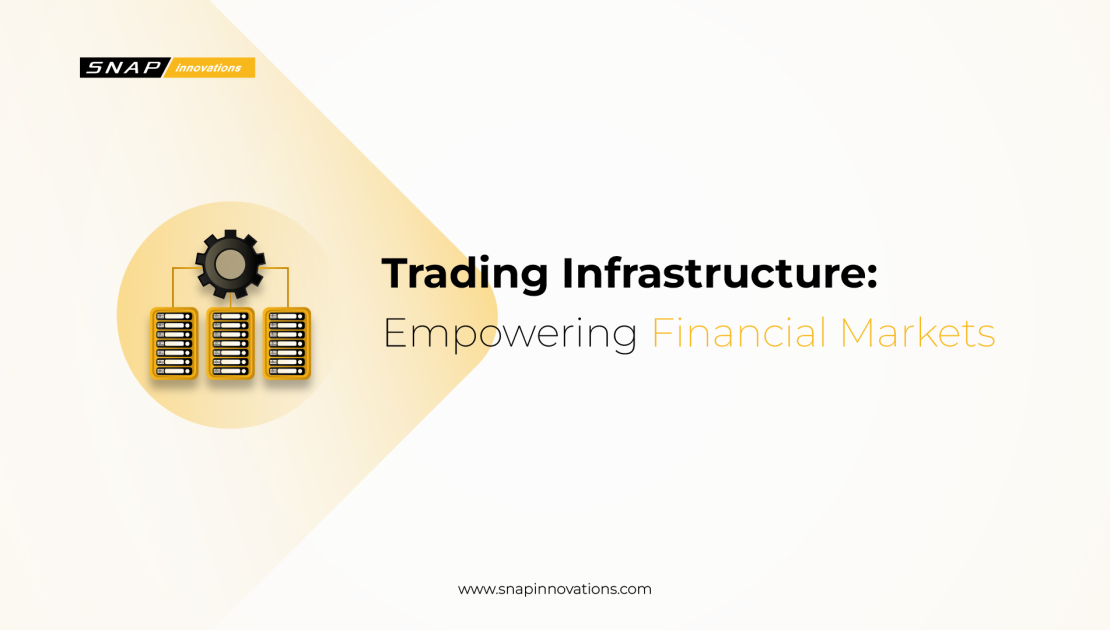In the fast-paced world of financial markets, where fortunes are made and lost in the blink of an eye, there’s an unsung hero that often goes unnoticed: trading infrastructure. It’s the behind-the-scenes powerhouse that enables traders, brokers, and financial institutions to execute orders swiftly and efficiently.
In this guide, we’ll delve deep into the fascinating realm of trading infrastructure, exploring its significance, components, challenges, and the profound impact it wields on the global financial landscape.
What is Trading Infrastructure?
Trading infrastructure, often lurking behind the scenes of the financial world, serves as the intricate technological framework that underpins the functionality of global markets. It’s the digital nervous system that enables traders, financial institutions, and investors to execute transactions with remarkable precision and speed. At its essence, trading infrastructure comprises a multifaceted ecosystem encompassing hardware, software, networks, and protocols, all working harmoniously to facilitate the seamless flow of financial assets.
Imagine a high-stakes poker game where every move counts. Trading infrastructure is the silent dealer shuffling and distributing cards, ensuring that the game proceeds smoothly. It’s the engine beneath the hood of financial markets, orchestrating the ballet of buying and selling, where billions of dollars change hands with the click of a button or the swipe of a finger. To truly grasp the significance of trading infrastructure, it’s like peeling back the layers of a sophisticated onion, revealing the myriad of components and technologies that power the global economy’s beating heart.
Whether you’re a seasoned trader, a financial institution navigating turbulent markets, or an intrigued observer, understanding the intricacies of trading infrastructure unveils the magic that makes the modern financial world tick. So, let’s dive deeper into this world, exploring its components, challenges, and profound impact on the tapestry of global finance.
Also Read: Short Call Options: A Basic Guide
The Components of Trading Infrastructure
Trading infrastructure is a composite structure, akin to the intricate machinery of a modern skyscraper. Its components work in tandem to provide a seamless trading experience. Here’s a breakdown of some key elements:
1. Exchange Platforms
These digital marketplaces serve as the epicenter of trading infrastructure, akin to bustling trading floors of the past. However, in today’s electronic age, these platforms have evolved into highly sophisticated systems that define the ebb and flow of global financial markets. They host a wide array of financial instruments, ranging from traditional stocks and bonds to cutting-edge cryptocurrencies and derivatives.
Each exchange specializes in specific asset classes, employing advanced technologies and protocols to facilitate seamless trading. The performance and reliability of these exchange systems are paramount, as they provide the critical interface where buyers and sellers converge to determine prices and execute transactions. Without these platforms, the global financial ecosystem would lack the central hubs that make markets accessible to all.
2. Data Feeds
In the fast-paced world of trading, timely and accurate market data is akin to oxygen. Data feeds deliver real-time information on asset prices, order book depths, trading volumes, and more. Traders rely on this constant stream of data to make informed decisions and execute orders with surgical precision. These feeds are meticulously curated, capturing every tick and trade, and are available in various formats, catering to the diverse needs of market participants.
From algorithmic traders seeking raw, unfiltered data to retail investors using user-friendly interfaces, data feeds form the foundation upon which trading strategies are built. They are the arteries through which market information flows, empowering traders with the insights needed to navigate the ever-shifting tides of financial markets.
3. Order Management Systems (OMS)
OMS is the central nervous system of trading infrastructure, where traders orchestrate their moves with a level of precision that rivals a conductor leading a symphony orchestra. It’s the digital cockpit where orders are not merely placed but crafted, modified, and managed in real-time. OMS bridges the gap between traders and exchanges, ensuring that orders are correctly routed to the right venues and promptly executed at the desired prices.
It’s not just about order placement; it’s about ensuring that traders have a comprehensive view of their positions, risk exposure, and the status of their orders. OMS provides the clarity and control that traders require to steer their portfolios through the often turbulent waters of financial markets.
4. Execution Management Systems (EMS)
EMS complements OMS by providing traders with a toolkit designed for executing orders efficiently and intelligently. It’s the Swiss Army knife that equips traders with advanced algorithms, enabling the execution of large orders with surgical precision, all while minimizing market impact. EMS also offers sophisticated smart order routing capabilities, continuously scanning multiple exchanges and dark pools to seek the best available prices and liquidity.
It’s the engine that powers high-frequency trading, algorithmic strategies, and the optimization of execution quality, making it an indispensable tool for traders navigating the complexities of modern financial markets. EMS is the conductor’s baton that allows traders to harmonize their strategies with the market’s ever-changing rhythm.
5. Network Infrastructure
In the digital age, speed is not just an advantage; it’s a necessity. Network infrastructure forms the backbone of trading, ensuring the swift and reliable transmission of data and orders. It involves high-speed connections, redundant links, and proximity hosting in data centers strategically positioned near exchange data centers to minimize latency. Every millisecond saved can be the difference between executing a profitable trade and missing a golden opportunity.
Network infrastructure is the highway on which financial information travels, and it must be built for speed and reliability to thrive in the competitive world of trading. It’s the digital expressway that connects traders with markets, compressing vast distances into fractions of a second and making global trading accessible to all.
6. Hardware and Co-location
Behind the screens and flashing numbers, powerful hardware drives the machinery of trading infrastructure. Financial institutions invest heavily in state-of-the-art data centers, where servers and hardware components are meticulously selected and configured for maximum performance and resilience. Co-location, the practice of placing servers in proximity to exchange data centers, further reduces latency and ensures seamless connectivity.
These data centers are equipped with redundant power supplies, advanced cooling systems, and robust security measures to guarantee uninterrupted operation, even in the face of unforeseen challenges. Hardware and co-location are the unsung heroes that provide the computational muscle and reliability needed to process the immense volumes of data and orders flowing through trading infrastructure.
7. Risk Management Systems
In the high-stakes arena of trading, risk management is paramount. Risk management systems continuously monitor trading activities in real-time, serving as vigilant sentinels against potential threats to portfolios. These systems employ advanced algorithms to calculate risk metrics, such as value at risk (VaR) and conditional value at risk (CVaR), providing traders and risk managers with invaluable insights to make informed decisions.
They are the safety nets that can swiftly detect unusual trading patterns or excessive risk exposure, alerting traders to take necessary actions to mitigate potential losses. Risk management systems are the guardians of financial stability, ensuring that portfolios remain resilient in the face of market turbulence.
8. Regulatory Compliance Tools
In today’s tightly regulated financial landscape, compliance is not just a box to tick; it’s a fundamental requirement. Trading infrastructure includes a suite of tools and systems designed to ensure that all trades adhere to the ever-evolving regulatory framework. These tools rigorously verify compliance with regulations, closely monitor trading activities for any suspicious behavior or market abuse, and maintain comprehensive audit trails to meet reporting requirements.
They are the guardians of market integrity and investor protection, ensuring that financial markets operate in a fair, transparent, and compliant manner. Regulatory compliance tools are the sentinels that uphold the rule of law in financial markets, fostering trust among participants and safeguarding the interests of investors.
As you delve into the intricacies of trading infrastructure, you’ll discover a fascinating tapestry of technologies and systems, each playing a crucial role in the seamless functioning of financial markets.
These eight components are not just cogs in a machine; they are the unsung heroes of modern finance, ensuring that trades are executed swiftly, accurately, and securely, from the bustling trading floors of yesteryears to the electronic realms of today. They are the pillars upon which the global financial ecosystem stands, providing the stability, efficiency, and transparency that underpin vibrant and accessible markets for all participants.
Challenges in Trading Infrastructure
 While trading infrastructure has brought about remarkable advancements in the world of finance, it is not without its array of challenges. One of the foremost hurdles lies in the relentless pace of technological evolution. As new technologies emerge and existing ones swiftly evolve, trading systems must remain at the cutting edge. This demands substantial investments in hardware, software, and human expertise to ensure that trading infrastructure can keep pace with the demands of modern markets. Cybersecurity presents another formidable challenge, given the increasing sophistication of cyber threats. Safeguarding the integrity and security of trading infrastructure is paramount, as a breach could have catastrophic consequences.
While trading infrastructure has brought about remarkable advancements in the world of finance, it is not without its array of challenges. One of the foremost hurdles lies in the relentless pace of technological evolution. As new technologies emerge and existing ones swiftly evolve, trading systems must remain at the cutting edge. This demands substantial investments in hardware, software, and human expertise to ensure that trading infrastructure can keep pace with the demands of modern markets. Cybersecurity presents another formidable challenge, given the increasing sophistication of cyber threats. Safeguarding the integrity and security of trading infrastructure is paramount, as a breach could have catastrophic consequences.
Market fragmentation is an ongoing challenge stemming from the proliferation of trading venues and the expansion of asset classes. While it offers greater choices for market participants, it can lead to issues related to achieving seamless connectivity and maintaining order in fragmented markets. Furthermore, the complex web of regulatory compliance is a perpetual concern. Navigating an ever-changing landscape of rules and regulations, which can vary significantly across jurisdictions, poses a formidable task for market participants and infrastructure providers alike.
Ensuring fair access to trading infrastructure and preventing monopolistic practices is an essential challenge in fostering a level playing field for all market participants. This involves addressing issues related to market concentration and competition to maintain healthy market dynamics. Finally, the pursuit of sustainability and responsible trading practices in an era of heightened environmental and social awareness presents challenges in aligning trading infrastructure with broader societal goals. Addressing these multifaceted challenges is vital to ensure the continued reliability, security, and fairness of trading infrastructure in today’s dynamic financial landscape while embracing the opportunities it offers.
The Impact of Trading Infrastructure
 The impact of trading infrastructure extends far beyond the trading floors and computer screens. It plays a pivotal role in shaping the broader financial landscape, influencing market dynamics, liquidity, and accessibility. High-frequency trading, for example, has become a dominant force in markets, accounting for a significant portion of trading volumes. While it has brought efficiency and liquidity, it has also raised questions about market stability and fairness.
The impact of trading infrastructure extends far beyond the trading floors and computer screens. It plays a pivotal role in shaping the broader financial landscape, influencing market dynamics, liquidity, and accessibility. High-frequency trading, for example, has become a dominant force in markets, accounting for a significant portion of trading volumes. While it has brought efficiency and liquidity, it has also raised questions about market stability and fairness.
1. Market Accessibility
Trading infrastructure has fundamentally transformed the landscape of financial markets by democratizing access. Gone are the days when trading was the exclusive domain of financial professionals on bustling trading floors. Today, thanks to trading infrastructure, it’s no longer limited to a select few; anyone with an internet connection can participate.
This increased accessibility has empowered retail investors, enabling them to invest in a diverse range of assets and build portfolios tailored to their financial goals. The impact is profound, as it fosters financial inclusion and widens the pool of market participants, leading to more diverse perspectives and trading strategies.
2. Market Liquidity
Liquidity is the lifeblood of financial markets, and trading infrastructure plays a pivotal role in shaping it. Efficient order routing and execution systems ensure that buyers and sellers can transact swiftly and at fair prices. Liquid markets are less prone to extreme price swings, reducing risks for all participants.
Furthermore, the presence of high-frequency traders and algorithmic strategies enhances market liquidity by providing continuous trading activity, even in turbulent times. The impact of robust liquidity is felt by investors as it allows for smoother entry and exit from positions, reducing trading costs and minimizing slippage.
3. Market Efficiency
The efficiency of trading infrastructure directly impacts market prices. Rapid dissemination of information and swift execution of orders ensure that asset prices incorporate the latest news and developments promptly. Efficient markets are more reflective of underlying fundamentals, providing investors with a level playing field and reducing opportunities for arbitrage.
As a result, investors can make more informed decisions, and markets are less susceptible to distortions caused by delayed information or inefficient trading mechanisms. The impact of market efficiency is evident in fairer pricing and increased confidence among market participants.
4. Risk Mitigation
Risk management systems are the safety nets that protect portfolios from unexpected events. These sophisticated systems continuously monitor trading activities in real-time, serving as vigilant sentinels against potential threats to portfolios. By identifying potential risks and alerting traders to take necessary actions, they help mitigate losses and preserve capital.
The impact of risk management is particularly evident during market turbulence when well-prepared traders can navigate choppy waters more effectively, reducing the severity of drawdowns. Risk mitigation also fosters long-term sustainability in trading strategies.
5. Regulatory Compliance
In an era of increasing regulatory scrutiny, regulatory compliance tools are indispensable. These tools ensure that market participants adhere to the rules and regulations governing financial markets. This not only fosters trust among investors but also ensures that markets operate within a transparent and fair framework.
The impact of regulatory compliance extends beyond individual traders; it upholds the reputation of financial markets as a whole, attracting institutional investors and enhancing market integrity. Compliance also plays a role in reducing systemic risks and protecting the stability of financial systems.
6. Global Connectivity
Trading infrastructure facilitates global connectivity, breaking down geographical barriers and allowing investors to access markets worldwide. It has contributed to the globalization of finance, enabling cross-border investment and diversification.
This interconnectedness has both opportunities and challenges, as events in one part of the world can ripple through global markets. The impact of global connectivity is evident in the diversification options available to investors, as they can now tap into a wide range of asset classes and regions. This diversification enhances portfolio resilience and risk management.
7. Innovation and Competition
The relentless pursuit of speed and efficiency in trading has driven continuous innovation in trading infrastructure. New technologies, trading algorithms, and execution methods continually emerge, pushing the boundaries of what’s possible. This innovation fosters healthy competition among market participants and infrastructure providers, leading to improved services, reduced costs, and enhanced trading experiences for all.
The impact of innovation is dynamic, as it constantly reshapes the trading landscape and provides traders with new tools and opportunities to gain an edge in the market. Innovation drives the evolution of trading strategies and approaches.
8. Market Surveillance
Surveillance systems are the watchdogs of financial markets. They play a crucial role in maintaining market integrity by continuously monitoring trading activities for any irregularities or potential market abuse. The impact is twofold: it deters malicious actors from engaging in manipulative practices, safeguarding the interests of all participants, and it ensures that markets operate with transparency and fairness, maintaining investor trust.
The impact of robust surveillance is felt by every participant, as it helps maintain the level playing field that is essential for the functioning of financial markets. Surveillance enhances market credibility and confidence.
The Future of Trading Infrastructure
 The future of trading infrastructure promises a captivating landscape of innovation and evolution, driven by the relentless march of technology and the ever-changing dynamics of global financial markets. Technology will remain the cornerstone, with several exciting trends set to reshape the landscape. Blockchain and distributed ledger technology (DLT) have the potential to revolutionize settlement processes, making them more efficient, secure, and transparent. These technologies hold the promise of near-instantaneous settlement of trades, reducing counterparty risks and unlocking capital for market participants.
The future of trading infrastructure promises a captivating landscape of innovation and evolution, driven by the relentless march of technology and the ever-changing dynamics of global financial markets. Technology will remain the cornerstone, with several exciting trends set to reshape the landscape. Blockchain and distributed ledger technology (DLT) have the potential to revolutionize settlement processes, making them more efficient, secure, and transparent. These technologies hold the promise of near-instantaneous settlement of trades, reducing counterparty risks and unlocking capital for market participants.
Artificial intelligence (AI) and machine learning (ML) are poised to play an increasingly pivotal role in trading. Advanced algorithms will continuously analyze vast datasets, optimizing trading strategies, and risk management systems. These AI-powered systems will not only identify trading opportunities but also adapt to changing market conditions in real-time, potentially reducing human intervention. Furthermore, quantum computing, although in its nascent stages, may introduce unprecedented speed and computational power to trading operations, revolutionizing complex calculations and simulations.
Market surveillance is set to undergo a profound transformation. Enhanced by AI and ML, surveillance systems will become highly sophisticated, capable of detecting even the most subtle irregularities and market abuses. This will bolster market integrity and investor confidence. Furthermore, environmental, social, and governance (ESG) considerations are expected to exert growing influence on trading practices. Responsible and sustainable investing will gain prominence, prompting market participants to integrate ESG factors into their decision-making processes.
Also Read: ISV Partnerships: New Business Opportunities and Innovations
Conclusion
In the ever-evolving world of financial markets, trading infrastructure remains the unsung hero, driving the efficiency, accessibility, and innovation that define modern trading. As we navigate the complexities of global finance, it’s essential to recognize the pivotal role that trading infrastructure plays in shaping our financial future.
As we embark on this exciting journey into the future, we must remain vigilant, innovative, and responsible custodians of this critical infrastructure, ensuring that it continues to serve as the backbone of financial markets for generations to come.

